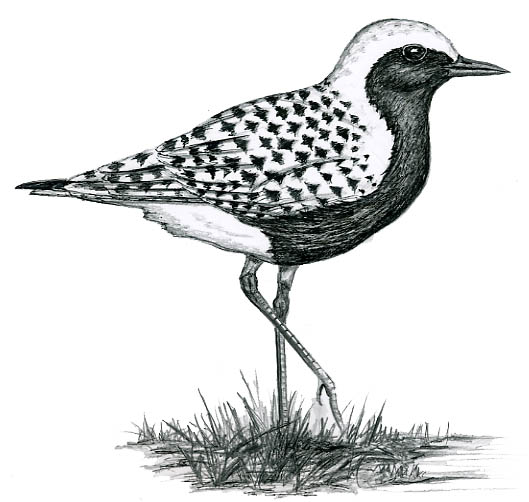
Dear Bird Folks,
I was wondering if anyone reported sighting a Black-bellied Plover at Duck Harbor in Wellfleet. I spotted one flying over the surf. I’m not a bird expert, so I checked out my field guide when I returned home and it seemed to be a perfect match. Are they usually found around here?
– Denise, Wellfleet, MA
Whew, Denise,
When I first got your note and read the word “plover,” I thought, “Oh, here we go again. Another fifty page complaint about Piping Plovers.” But thankfully, I was wrong. Sorry if I’m a bit paranoid, but it seems that every time someone is upset with a bird, it is somehow my fault and I have to hear about it. I certainly gave a sigh of relief when I read that the plover you were inquiring about was a Black-bellied Plover. I’m okay now.
A few people may have issues with the little Piping Plover, but I don’t know anybody who has a problem with the Black-bellied Plover. They are so neutral I don’t even think they know they are plovers. No one has ever complained to me about a Black-bellied Plover closing a beach, pooping on their deck, flying at their window or waking them up in the morning. In fact, unless you happen to be a mollusk or a bloodworm, you probably will never have any conflicts with a Black-bellied Plover. Now, I don’t want to take anything away from your sighting, Denise, but here on Cape Cod Black-bellied Plovers are not unusual. They can be found any day of the year. And during their fall migration (August and September) we are thick with them. It would be hard to find a marsh or mudflat that doesn’t have several of them picking about.
Like you said, they are a perfect match in the field guides. In the world of shorebirds, where many of the birds are maddeningly similar, black-bellies are actually identifiable. If we forget about their assortment of plumages for a minute, this bird can be identified by its shape, behavior and call. Black-bellies are chubby birds with rounded heads, stout bills and extra large dark eyes, which they use for foraging at night. This plover doesn’t dig in the mud nearly as much as many other shorebirds do, instead, it feeds like a robin. It runs a few feet, scans for a something slimy to eat and then runs a few more feet to scan again.
The black-belly’s distinctive call is well worth learning for it will help you with identification in any situation. The call is a sad, mournful whistle that sounds like someone who’s been looking for a lost dog and is about to give up. At close range this plover’s call is rather loud and is often so earsplitting that it makes you glad that you never married one.
Learning to identify the black-belly by its shape, behavior and call are important because the plumage is variable and constantly changing. Since we see them year-round, it’s good to be prepared for their different looks. In the winter, Black-bellied Plovers are gray, drab and generic, looking like a chunk of steel wool on stilts. It is during the breeding season they have the distinctive jet black belly, for which they are aptly named. In the spring and fall we see birds that are in transition between the breeding and winter plumages. Learning this bird’s shape, behavior and call would save you a lot of squinting and head scratching.
Even though we see Black-bellied Plovers year-round, they don’t breed here or anyplace near here. Their breeding grounds are way the heck up north, above the Arctic Circle. These remote nesting grounds have served the birds well, for their population has not suffered the same losses as their cousins, the Piping Plover, have. That foolish bird made the mistake of trying to live in harmony with us humans.
The Black-bellied Plover not only doesn’t nest near people, it does its best to avoid us altogether. It is very wary and is usually the first shorebird to fly off when anything wearing an L.L. Bean outfit approaches. It is this distrust of humans that prevented the Black-bellied Plover from suffering the same fate that befell many other shorebirds during the dark days of commercial hunting.
Black-bellied Plovers are widespread and can be found on many of the world’s coastlines. In addition to North America, they spend time in South America, Africa, the Mediterranean and Australia. In America, black-bellies can be confused with the Pacific and American Golden-Plovers, but the black-belly is the only one of the group with an extra back toe. So, if you aren’t sure which plover you are seeing just count the toes as the birds fly past at 57 MPH and you’ll be good to go.
Even though black-bellies are common around here, Denise, it’s always nice to see them. Just remember, they are skittish and will take off if they spot people or anything wearing an L.L. Bean outfit. But who can blame them for that?